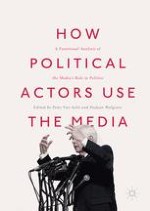2017 | OriginalPaper | Chapter
2. An Intervening Intermediary: Making Political Sense of Media Influence
Author : Gunnar Thesen
Published in: How Political Actors Use the Media
Publisher: Springer International Publishing
Activate our intelligent search to find suitable subject content or patents.
Select sections of text to find matching patents with Artificial Intelligence. powered by
Select sections of text to find additional relevant content using AI-assisted search. powered by
